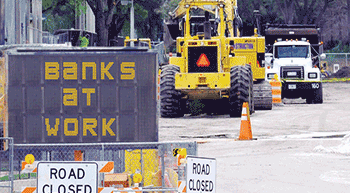The logistics industry has always been an underdog and has not received the much-deserved attention yet. Though the sector is full of potential, it is yet to achieve optimal utilisation of resources.
FlashNews:
NHAI Launches Internship Programme to Build Highway Talent Nationwide
Powerplay Rolls Out Procurement-Linked Credit to Unlock Contractor Cash Flows
IREDA Earns ‘Excellent’ MoU Rating for Fifth Year, Cementing Role in Clean Energy Financing
Inox Clean Energy Secures ₹31 Billion Equity at ₹500 Billion Valuation
Centre’s ₹2.35 Billion Port Push in Tamil Nadu, Sonowal Flags Maritime-Led Growth
Indian Railways to Roll Out 52 Reforms in 52 Weeks; Targets Single-Digit Accidents by FY2027
India Stays the Course as Combative Trump Exits International Solar Alliance
Energy Security, Investment and Decarbonisation to Take Centrestage at India Energy Week 2026
PM Modi Hails HPCL’s World-First LC-Max Residue Unit at Visakh Refinery
NHAI Urges DoT and TRAI to Fix Mobile Connectivity Gaps on National Highways
With Joshi at the Wheel, Gadkari Joins Hydrogen Car Drive to Signal India’s Clean Mobility Push
ONGC Partners MOL to Launch Ethane Shipping, Strengthening Energy Logistics and Maritime Presence
DFCCIL Uses GPS to Bust ERC Theft in Ambala, Averts Rail Mishap
Bhogapuram Airport Nears Completion as GMR Conducts Successful Validation Flight
Power Minister Manohar Lal Reviews Strategic Hydropower Projects in J&K
Inox Clean Energy Acquires 300 MWp SunSource Portfolio to Power Growth
Accelerating Sustainable Energy Sector Growth with the Power of AI
Advantage Assam: Trust, Governance and Growth Under Prime Minister Modi
Near Western Dedicated Freight Corridor Completion, DFCCIL Chief Inspects JNPA‑Vaitarna Stretch
Affordable Housing: Untapped potential whose time has come
The demand within the affordable housing segment remains robust. Given that the target customer of this segment typically relies on bank funding. Consequently, ICRA research has taken a note of the significant growth in the sub Rs 250 million category.
Enroute to Recovery
Logistics industry has always been an underdog and has not received the much-deserved attention yet. Though the sector is full of potential, it is yet to achieve optimal utilisation of resources.
Cement demand up but profitability pressures continue
Even as demand for cement has picked up from Q3 FY2018 and the trend is expected to continue in Q4 FY2018, with the growth expected at around 5% in FY2018 and FY2019, expectation of higher petcoke, coal and diesel prices are likely to put pressure on the profitability margins and debt metrics of the cement companies in the coming quarters.
Rs 19,435 crore toll projects maybe at risk
The Bharatmala network designed on the shortest possible route connecting the origin and destination, though a well thought through and definitely a step in the right direction, is bound to impact the existing network by directly competing with a few stretches including some of the existing BOT (Toll) road projects.
Steel shining!
India is the third largest steel producer in the world after China and Japan and has an installed capacity of about 131 million tonne (mt) at present. It produced 101 mt of steel in FY2017 and consumed 84 mt during the same period.
India’s Metro Trail
The total length of operational metro projects in India presently stands at about 440 km and is growing. Cities like Bengaluru, Chennai, Gurugram, Kochi, Kolkata, Mumbai, Hyderabad, Jaipur, Lucknow and the Delhi National Capital Region (NCR) where they are already operational, are simultaneously adding on to their existing route networks.
Post Budget Analysis | OIL & GAS
Provision of revenue expenditure/subsidy for sensitive petroleum products of ~Rs 217 billion for FY2019 and 2018v19 (BE), excluding allocation of new LPG connections to poor families.
GovernmentÂ’s focus on road sector yields positive results: ICRA
Effective policy measures by the Government over the last 36 months have revived the Indian road sector and supporting the execution pace. According to ICRA, these include steps like awarding projects after securing 80 per cent right of way; expediting projects stuck midway, delegating the power to grant forest clearances to regional offices, online filing for clearances to construct ROB and RUBs and increasing the limit on sand mining.
OPERATION IN(FRA)SOLVENCY
With over Rs11 lakh crore debt, project investments worth Rs.32.7 lakh crore and cost overrun of Rs14.35 lakh crore is at stake, the current Insolvency and Bankruptcy Code 2016 is a sigh of relief for India's financial institutions.








